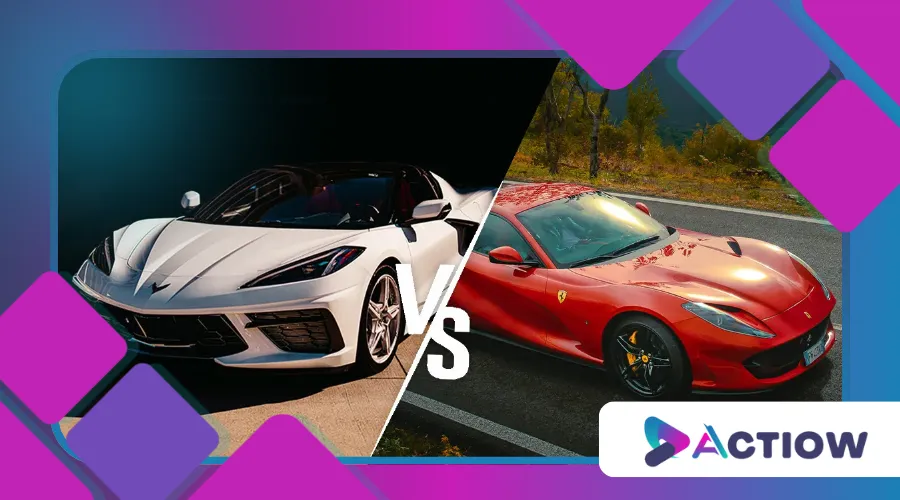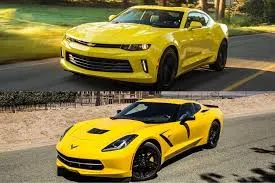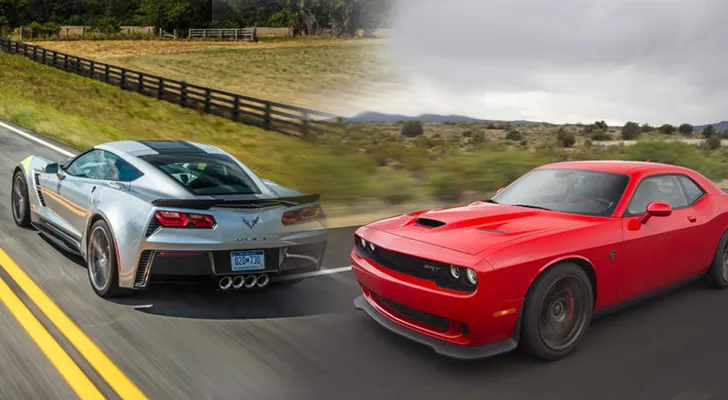Muscle Cars vs. Supercars: What’s the Difference?

Anúncios
Muscle cars vs. supercars, a debate that sparks passion among automotive enthusiasts, pitting raw American power against sleek, precision-engineered performance.
These two categories of high-performance vehicles represent distinct philosophies, histories, and engineering approaches, each with its own cult following.
But what truly sets them apart?
Anúncios
This article dives deep into the essence of muscle cars and supercars, exploring their origins, design principles, performance metrics, cultural significance, and modern relevance.
With a blend of technical insight and cultural context, we’ll unravel why these machines captivate hearts and whether one reigns supreme.
Origins: A Tale of Two Worlds
The story of muscle cars begins in the post-World War II United States, where a booming economy and a thirst for freedom fueled automotive innovation.
Muscle cars were born from the idea of stuffing oversized V8 engines into midsize sedans, creating affordable, tire-shredding machines for the everyman.
Think of the 1964 Pontiac GTO, often credited as the first true muscle car, with its 389-cubic-inch V8 pumping out 325 horsepower.
These cars were unapologetically loud, brash, and built for straight-line speed, embodying the rebellious spirit of the 1960s.
Supercars, by contrast, trace their lineage to Europe’s aristocratic racing heritage.
Emerging in the mid-20th century, they were crafted as engineering masterpieces, blending cutting-edge technology with aerodynamic elegance.
The 1966 Lamborghini Miura, with its mid-engine layout and 350-horsepower V12, redefined what a road car could be.
Supercars weren’t just about speed; they were about precision, handling, and exclusivity, designed for those who could afford the pinnacle of automotive artistry.
The distinction between these two worlds reflects broader cultural values—muscle cars celebrate accessibility and power, while supercars epitomize luxury and innovation.
Design and Engineering: Power vs. Precision
Muscle cars are the sledgehammers of the automotive world.
Their design prioritizes raw power over finesse, with large-displacement V8 engines, rear-wheel drive, and minimal aerodynamic consideration.
A modern example, the 2023 Dodge Challenger SRT Hellcat Redeye, boasts a supercharged 6.2-liter V8 producing 797 horsepower.
Its boxy, retro-inspired body screams nostalgia, but its engineering is straightforward: deliver overwhelming force in a straight line.
Suspension tuning and weight distribution often take a backseat to sheer grunt.
Supercars, however, are surgical instruments.
They integrate lightweight materials like carbon fiber, advanced aerodynamics, and sophisticated suspension systems to achieve balance.
Take the 2024 McLaren Artura, a hybrid supercar with a 3.0-liter V6 and electric motor combining for 671 horsepower.
Its active aerodynamics and adaptive dampers allow it to carve corners with surgical precision.
Supercars often employ mid-engine or all-wheel-drive layouts to optimize weight distribution and grip.
+ Tips for Driving on Dirt Roads Without Damaging Your Car
Here’s a quick comparison of design priorities:
| Aspect | Muscle Car | Supercar |
|---|---|---|
| Engine | Large V8, high displacement | Smaller, high-revving, often hybrid |
| Weight | Heavy (3,500–4,500 lbs) | Light (2,500–3,500 lbs) |
| Aerodynamics | Minimal, retro styling | Advanced, active aero |
| Suspension | Basic, tuned for drag racing | Adaptive, tuned for cornering |
This contrast underscores a key philosophical difference: muscle cars are built to dominate, while supercars are engineered to dance.

Performance: Drag Strip or Racetrack?
Imagine muscle cars vs. supercars as a heavyweight boxer facing a martial artist.
The boxer (muscle car) relies on brute force, landing devastating punches in a straight-line brawl.
The martial artist (supercar) uses agility, weaving through opponents with calculated precision.
This analogy captures their performance divide.
Muscle cars excel in quarter-mile sprints.
The 2023 Ford Mustang Shelby GT500, with its 760-horsepower supercharged V8, can hit 0–60 mph in 3.3 seconds and complete the quarter-mile in under 11 seconds.
But throw it into a tight corner, and its 4,200-pound frame struggles to keep up, with body roll and understeer revealing its drag-strip roots.
Supercars, meanwhile, are racetrack royalty.
The 2024 Porsche 911 GT3 RS, powered by a 4.0-liter flat-six producing 518 horsepower, hits 0–60 mph in 3.0 seconds and laps Germany’s Nürburgring in 6:44.848—nearly 20 seconds faster than any muscle car.
Its lightweight construction, rear-axle steering, and massive downforce make it a cornering beast.
A 2023 study by Car and Driver found that supercars consistently outperform muscle cars in lateral grip, with an average skidpad rating of 1.1g compared to 0.9g for muscle cars.
This statistic highlights why supercars dominate twisty circuits, while muscle cars rule the drag strip.
For a deeper dive into performance metrics, visit MotorTrend.
Cultural Significance: Everyman vs. Elite
Muscle cars are America’s automotive heartbeat.
They represent blue-collar grit, cruising Main Street, and the DIY spirit of backyard mechanics.
Picture a 1970 Plymouth Barracuda rumbling through a small town, its HEMI V8 shaking the pavement.
It’s a symbol of freedom, accessible to anyone with a wrench and a dream.
Even today, muscle cars like the Chevrolet Camaro ZL1 remain relatively affordable, with a starting price around $75,000.
Supercars, on the other hand, are the stuff of posters and fantasies.
They symbolize wealth, innovation, and exclusivity, often costing $200,000 or more.
The 2024 Ferrari SF90 Stradale, priced at $525,000, isn’t just a car—it’s a status symbol.
Supercars appeal to collectors and enthusiasts who value rarity, with limited production runs amplifying their allure.
This cultural divide raises a question: Are muscle cars vs. supercars a clash of accessibility versus aspiration?
Muscle cars invite everyone to the party; supercars demand an exclusive guest list.
Both categories reflect the values and aspirations of their respective audiences, shaping their identities and communities.

Modern Evolution: Adapting to a New Era
The automotive landscape is shifting, with electrification and emissions regulations reshaping performance cars.
Muscle cars are adapting, but their ethos remains intact.
The 2024 Dodge Charger Daytona SRT, an all-electric muscle car, delivers 670 horsepower and a 0–60 mph time of 3.3 seconds.
It retains the aggressive styling and tire-shredding ethos of its gas-powered ancestors, proving muscle cars can evolve without losing their soul.
Supercars, too, are embracing electrification.
The 2024 Rimac C_Two, an electric hypercar, produces 1,914 horsepower and hits 0–60 mph in 1.85 seconds.
Yet, it maintains the supercar focus on cutting-edge tech and track prowess, with advanced torque vectoring and a carbon-fiber chassis.
Hybrids like the McLaren Artura also blend efficiency with performance, appealing to eco-conscious buyers without sacrificing speed.
Here’s how modern examples stack up:
| Model | Type | Powertrain | 0–60 mph | Price |
|---|---|---|---|---|
| Dodge Charger Daytona | Muscle Car | Electric, 670 hp | 3.3 sec | ~$80,000 |
| Rimac C_Two | Supercar | Electric, 1,914 hp | 1.85 sec | ~$2,000,000 |
This evolution shows both categories adapting to modern demands, but their core identities—power for muscle cars, precision for supercars—remain unshaken.
++ Wireless Charging Technology for Electric Cars
Practicality and Ownership: Daily Driver or Weekend Toy?
Owning a muscle car is like adopting a loyal, slightly unruly dog.
They’re practical enough for daily driving, with spacious interiors and large trunks.
The 2023 Chrysler 300 SRT, for example, offers a comfortable ride and a 16.3-cubic-foot trunk, making it a viable family hauler.
Maintenance is straightforward, with parts widely available and affordable.
However, fuel economy is abysmal—expect 15 mpg combined.
Supercars are more like exotic pets.
They’re thrilling but demanding, with cramped cabins, limited storage, and high maintenance costs.
The 2024 Aston Martin DB12 AMR has a 2.8-cubic-foot trunk, barely enough for a weekend bag.
Repairs often require specialized technicians, and annual maintenance can exceed $10,000.
Fuel economy is marginally better, but still poor at 17 mpg.
For the average enthusiast, a muscle car offers more practicality, while a supercar demands a lifestyle commitment.
This practical divide often influences buyers’ decisions, reflecting their lifestyle and driving needs.
The Verdict: Which Reigns Supreme?
Choosing between muscle cars vs. supercars depends on what you value.
If you crave raw power, affordability, and a connection to American heritage, muscle cars deliver unmatched thrills.
They’re the automotive equivalent of a rock concert—loud, chaotic, and unapologetic.
For those who prioritize precision, exclusivity, and cutting-edge tech, supercars offer a refined, almost otherworldly experience, like a perfectly choreographed ballet.
Consider two fictional enthusiasts: Jake, a mechanic who restores a 1969 Dodge Charger in his garage, relishing its thunderous roar on weekend cruises.
Then there’s Sofia, a tech entrepreneur who tracks her Porsche 911 Turbo S, savoring its surgical precision.
Both find joy, but in different ways.
Ultimately, the debate of muscle cars vs. supercars isn’t about superiority—it’s about passion.
Each represents a unique vision of performance, shaped by history, engineering, and culture.
So, which speaks to you: the rebel’s roar or the artist’s finesse?
